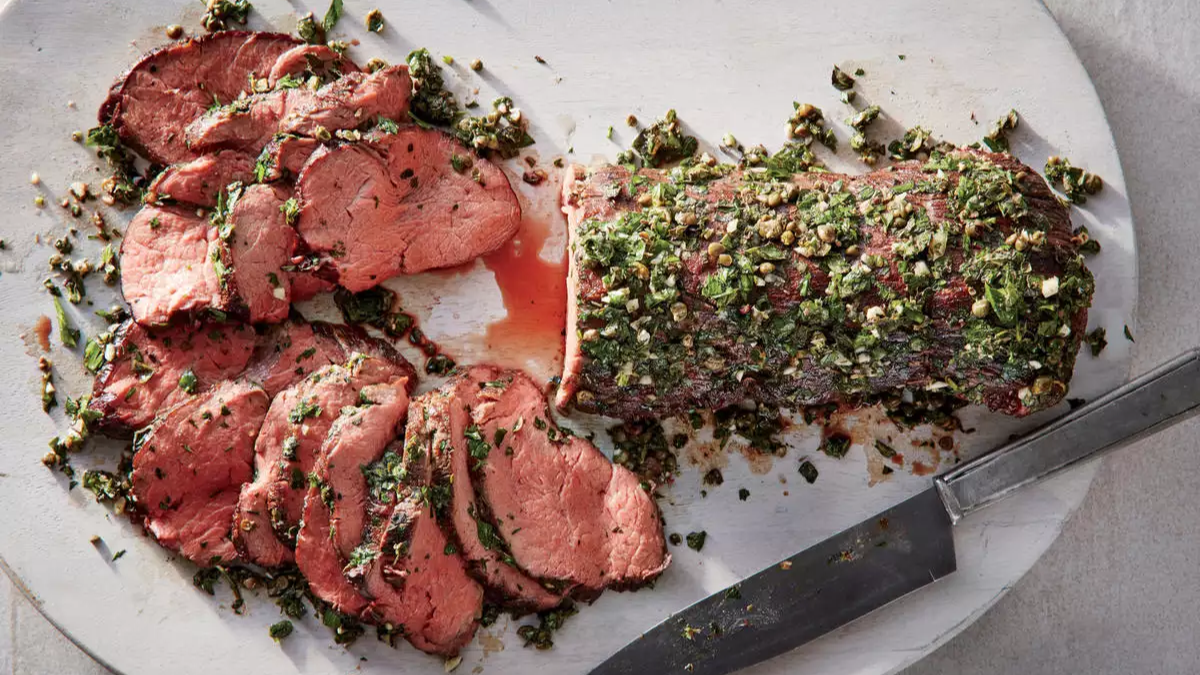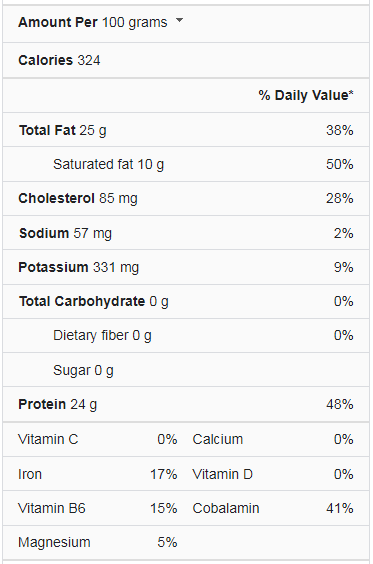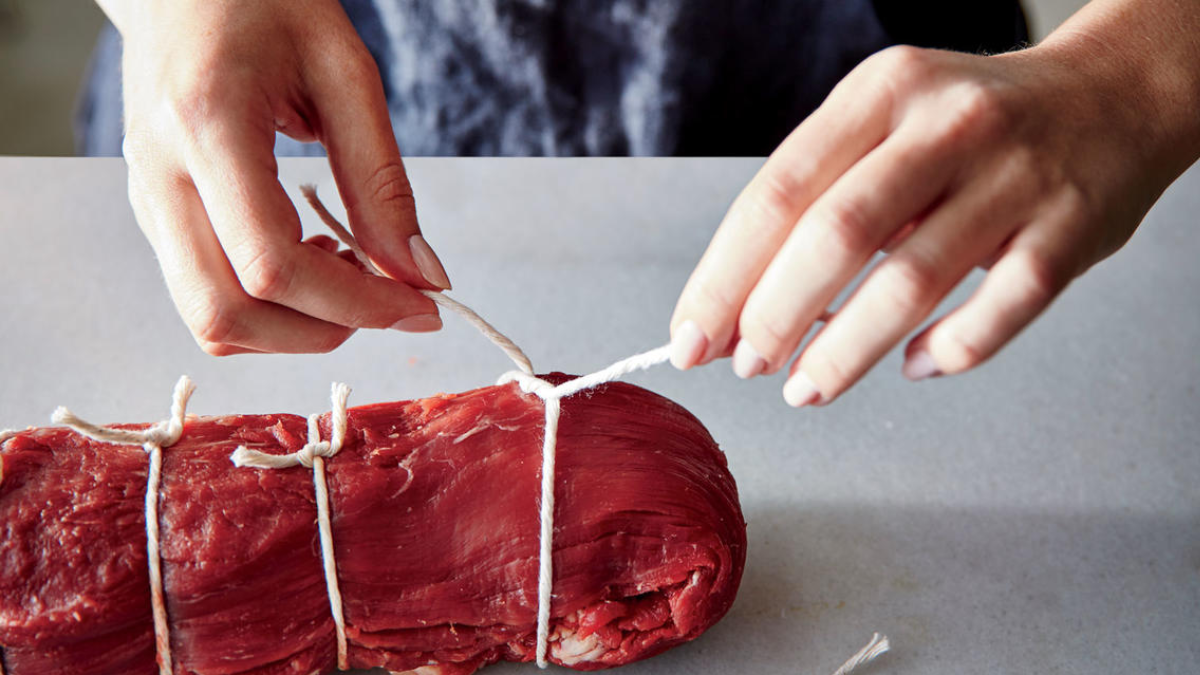The most tender cut of beef is often recognized as the tenderloin and the priciest. It is a piece of the perennially popular T-bone or porterhouse steak, and it is also used to make the fancy filet mignon. Before being completed in the oven, these tender steaks benefit from a brief sear on the stovetop. A tenderloin can either be cooked whole or divided into smaller roasts.
The beef tenderloin is situated between the sirloin and top sirloin, close to the cow’s back. It terminates where the short loin begins and continues lengthwise into the sirloin. Because it contains more fat and richer marbling than sirloin, tenderloin is simple to differentiate from.
Beef Tenderloin Nutrition Facts
What is Exactly Beef Tenderloin?
The short loin and the sirloin are the two primal cuts of beef that make up the sub-primal cut known as beef tenderloin. It is under the ribs near the spine and comprises the psoas major muscle. In various parts of the world, it is also known by the names eye fillet, fillet, or tenderloin.
It is regarded as the most tender beef cut, despite being relatively small muscle compared to a cow’s overall size. This makes it generally the most expensive cut of beef, in addition to its excellent flavor.
Beef tenderloin is used in several well-known meals, such as Chateaubriand and filet mignon steak. This cut of beef is occasionally used in other recipes that call for extremely tender beef. It is incredibly sensitive and has a very fine texture. While it has relatively low-fat content and is fairly lean, some better grades may have greater marbling.
Tenderloin Taste
The tenderloin is a lean cut of meat with relatively minimal marbling or intramuscular fat. And one of the key elements in making a piece of beef moist and tasty is marbling. Therefore, if you overcook beef tenderloin, it will get dry. Furthermore, despite its popularity, it’s not known as a particularly tasty cut of beef, which is why a strip of bacon is frequently wrapped around a tenderloin steak before cooking. Adding bacon gives a steak flavor and wetness that it might not have otherwise.
What are the Types of Beef Tenderloin?
The key to the complete beef short loin is the tenderloin. It must be decided whether to keep the tenderloin in or remove it before butchering either side of the cattle. The short loin can be cut into boneless top loin steaks, often referred to as strip steaks, if the tenderloin is removed, which is frequently done. The short loin can be cut into T-bone and porterhouse steaks if the tenderloin is kept. These are bone-in steaks with a strip loin part on one side and a tenderloin section on the other.
- A piece of the tenderloin will stay in the sirloin when T-bone and porterhouse steaks are produced. The butt tender, located at the back of the tenderloin, can be removed, trimmed, and sold as a roast or divided into separate steaks.
- The tenderloin is formed like a pencil, with the pointed end facing the front and the fat end at the back (the sirloin end). Since it can’t be cut into a steak, this pointed tip can be difficult to use, but if it’s left attached to the roast, it can quickly overcook. Therefore, you should fold the tip over and attach it to the main portion of the roast when roasting a full tenderloin.
- Another popular method for dealing with the tenderloin’s skinny portion is to cut a longer chunk, approximately two inches long, and then butterfly it. This results in a broader steak that is around an inch thick. The tenderloin tip can also be cut off and utilized as meat for stir-fries, kabobs, or small appetizers.
- The pointed tip is just adjacent to the filet mignon. You can cut medallions where the tenderloin spreads further down. To retain the wing and tenderloin muscles, butt tender steaks are occasionally knotted with butcher’s string.
Beef Tenderloin vs. Filet Mignon: What are the Differences?
Both filet mignon and beef tenderloin are pricey beef steaks you can buy for a special event. Find out how these two cuts of beef differ from one another. Beef tenderloin and filet mignon steaks differ in location and portioning; the former is a small, prized portion of the latter. The variations between these meat cuts are as follows:
Size
The filet mignon is part of the bigger beef cut known as the tenderloin. Purchase the entire tenderloin (or a sizable portion) from your grocery store or butcher if you want to prepare a sizable, sharing meat dish like beef Wellington. Ask for a filet mignon if you want to grill the best steak.
Regional Butchery Style
The filet mignon (and other tenderloin portions) may be available in various cuts depending on where you are. In France, the butchers dissect the cattle into different muscle groups. With the filet mignon at the front, the châteaubriand in the middle, and the biotech at the rump end of the tenderloin, they cut the tenderloin into portions after removing it from the carcass. The tenderloin is a portion of a larger steak cut in butchery done in the American manner: Porterhouse steaks and T-bone steaks both come with filet mignon and châteaubriand, respectively.
Cooking Speed
When cooking, fat, and bones act as insulators and slow down the process. Because it is boneless and has little fat, filet mignon cooks quickly. Filet mignon should be quickly seared in a hot oven-safe skillet (such as a cast-iron pan) until a brown crust forms, about two minutes per side, and then placed in the oven to complete cooking for a few minutes. (Alternatively, omit the oven and pan-fry the filet mignon for three to eight minutes per side, depending on thickness.)
Cooking Method
Whole beef tenderloin is a popular roasting cut because of its size: Larger portions of beef tenderloin should be roasted on a roasting rack for under an hour at 425 degrees for medium-rare has an internal temperature of 135 degrees. Before cutting, the meat needs to rest for ten minutes. An alternative is to cook a tenderloin roast slowly and then finish it with a broiler to get the outside seared.
Buying Advice
When purchasing beef tenderloin, it’s crucial to consider two things:
- The first consideration is how many people you will be feeding while cooking. As a general rule, purchase one beef tenderloin pound per person. Although beef shrinks while cooking, this guideline takes shrinkage into account. If you’re concerned that the main beef dish won’t be sufficient, you can serve it with hearty side dishes.
- The recipe you wish to use is the second element you must consider. You can choose which portion of beef tenderloin to purchase using the recipe.
- Purchasing the filet mignon or beef tenderloin tail would be a perfect choice for barbeque dishes. You can purchase the tail for full roasts.
- On the other hand, you can purchase filet mignon as a complete or in different steak cuts if you wish to serve individual steaks. Individual filet mignon steaks will be ideal if you cook for a couple.
Some Additional Factors
- The chateaubriand cubes can be used to cook kebabs that are juicy and tender. The entire Chateaubriand can be purchased from the butcher and cut into cubes by you. In stores, the head is typically offered in smaller cubes or strips.
- The names of the several beef tenderloin cuts—tail, filet mignon, muscle on the roast, and small roast—are listed in supermarkets. However, in some regions, Chateaubriand is also known as tenderloin head.
- These beef tenderloin cuts can either be described as trimmed or untrimmed. Beef tenderloin parts with extra fat around the meat are untrimmed. Although they can be a little less expensive than trimmed pieces, you will still need to cut the extra fat.
- Untrimmed beef tenderloin will have an undissolved layer of fat on the sides after cooking if the extra fat is not removed. This may affect the flavor of the meat or make it even softer to the point where it shreds as it cooks.
You can get meat from a butcher if you have any doubts about the freshness of the beef in supermarkets. Any time you purchase beef, whether it be beef tenderloin or another cut, be sure the meat is fresh and came from cows raised using humane agricultural methods. To check for freshness, look for a purplish-red tint on the meat.
How to Cook Beef Tenderloin?
The tenderloin should be cooked rapidly over high heat (such as on the grill) to achieve a well-browned exterior and a juicy, medium-rare interior. Additionally, you may cook it in a 450 F oven after searing it in a scorching hot skillet on the stovetop.
High-end steaks typically only require kosher salt and freshly ground black pepper for seasoning. However, beef tenderloin can also profit from a brief immersion in a delicious marinade due to its extreme leanness. You may also serve it with a buttery, smooth béarnaise or a red wine pan sauce.
Beef tenderloin can be kept in the refrigerator for up to three days in its original packaging. It can last up to six months in the freezer and around three weeks in the refrigerator when packaged in vacuum-sealed. The beef tenderloin should be defrosted overnight, either in the fridge or in a sink of cold water. Any cooked meat left over should be placed in the refrigerator immediately and used within three days.
Conclusion
A larger cut of beef, known as beef tenderloin, contains the entire tenderloin muscle. The tenderloin is a large muscle that extends from the loin primal to the sirloin primal, measuring eighteen to twenty-four inches long. Because it is a delicate and pricey cut of beef, beef tenderloin should only be used in barbecue dishes like roasts and steaks. It can taste fantastic when prepared correctly and served with warm, filling sides using any manner. With various roasted vegetables, it tastes fantastic—the tender and juicy beef steaks pair nicely with roasted tomatoes and potatoes. But you can also serve it with beans or rice.



